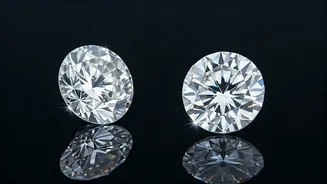What is Moissanite?
Moissanite, originally discovered in a meteor crater, is a gemstone that has gained popularity as an alternative to diamonds. Primarily composed of silicon
carbide, moissanite is known for its exceptional brilliance and fire, which are the flashes of color emitted when light passes through the stone. This makes moissanite a visually stunning option for jewelry. Its lab-created nature also ensures a consistent supply. For those seeking ethical and budget-friendly choices in gemstones, moissanite offers a compelling alternative.
The Sparkle Factor
The way a gemstone reflects light is a crucial aspect of its appeal, and this is where brilliance and fire come into play. Diamonds are renowned for their brilliance, the white light reflected back to the viewer. However, moissanite often surpasses diamonds in terms of fire, displaying more colorful flashes. The cut of a stone significantly influences these light-based characteristics. A well-cut diamond or moissanite will maximize its sparkle. Due to its higher refractive index, moissanite can sometimes appear to have more fire than a diamond, making it a very eye-catching choice.
Hardness and Durability
Durability is essential when selecting a gemstone, especially for pieces worn daily. The Mohs scale of hardness measures a mineral's resistance to scratching. Diamonds top this scale with a score of 10, making them incredibly resistant to damage. Moissanite scores a 9 to 9.5, indicating it is also highly durable and can withstand the wear and tear of everyday use. This makes both diamond and moissanite suitable for jewelry intended for frequent wear, such as engagement rings and other pieces that are always on display.
The Price Comparison
Cost is a major consideration for most buyers. Diamonds are generally more expensive due to their rarity and the complexities of the diamond market. The price of a diamond depends on the '4 Cs' – carat, cut, clarity, and color – which influence its value. Moissanite offers a more budget-friendly alternative. Since it is lab-created, moissanite can be produced in larger quantities, leading to lower prices. This makes moissanite an attractive choice for those wanting a brilliant gemstone without the premium price tag of a natural diamond.
Clarity and Color
The clarity of a gemstone refers to the absence of inclusions and blemishes. Diamonds are graded for clarity, with higher grades indicating fewer imperfections. Natural diamonds often have inclusions visible under magnification, while lab-grown moissanite typically exhibits fewer. Both can come in a range of colors, from colorless to slightly tinted. The color of a diamond is graded on a scale, with colorless diamonds being the most valuable. Moissanite is also available in various grades, but its inherent brilliance and fire can sometimes give it a slightly warmer appearance compared to a perfectly colorless diamond.
The Final Verdict
Both diamonds and moissanite present compelling options for jewelry. Diamonds offer classic appeal and long-term value, while moissanite provides remarkable brilliance and cost savings. Your ultimate decision should reflect your personal preferences, budget, and priorities. If you value investment and prestige, a diamond might be the perfect choice. If budget is a bigger concern, or if you prefer a visually stunning stone, moissanite offers an excellent alternative with similar beauty and exceptional value.














